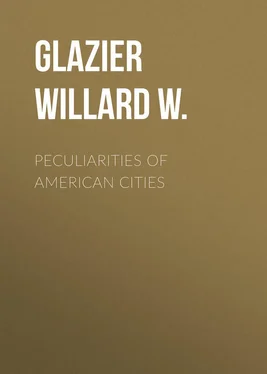Willard Glazier - Peculiarities of American Cities
Здесь есть возможность читать онлайн «Willard Glazier - Peculiarities of American Cities» — ознакомительный отрывок электронной книги совершенно бесплатно, а после прочтения отрывка купить полную версию. В некоторых случаях можно слушать аудио, скачать через торрент в формате fb2 и присутствует краткое содержание. Жанр: foreign_antique, foreign_prose, Путешествия и география, на английском языке. Описание произведения, (предисловие) а так же отзывы посетителей доступны на портале библиотеки ЛибКат.
- Название:Peculiarities of American Cities
- Автор:
- Жанр:
- Год:неизвестен
- ISBN:нет данных
- Рейтинг книги:3 / 5. Голосов: 1
-
Избранное:Добавить в избранное
- Отзывы:
-
Ваша оценка:
- 60
- 1
- 2
- 3
- 4
- 5
Peculiarities of American Cities: краткое содержание, описание и аннотация
Предлагаем к чтению аннотацию, описание, краткое содержание или предисловие (зависит от того, что написал сам автор книги «Peculiarities of American Cities»). Если вы не нашли необходимую информацию о книге — напишите в комментариях, мы постараемся отыскать её.
Peculiarities of American Cities — читать онлайн ознакомительный отрывок
Ниже представлен текст книги, разбитый по страницам. Система сохранения места последней прочитанной страницы, позволяет с удобством читать онлайн бесплатно книгу «Peculiarities of American Cities», без необходимости каждый раз заново искать на чём Вы остановились. Поставьте закладку, и сможете в любой момент перейти на страницу, на которой закончили чтение.
Интервал:
Закладка:
As for the immeasurable realm of books, Buffalo furnishes her children access to this, through her libraries. Chiefest among them is the Grosvenor, which has a bit of history all by itself. It was founded by a retired merchant of New York, who had lived in Buffalo during the earliest infancy of the city, and whose property had been destroyed when the then frontier village was fired by the British and Indians, in retaliation for the burning of Newark. This generous gentleman also left thirty thousand dollars to found a reference library for the High School of New York City. His will provided a legacy of ten thousand for Buffalo, to be applied towards a fire-proof building for a library, and the sum of thirty thousand, the interest of which was to be used for the purchase of books. The building fund having been on interest ever since, now amounts to twenty-eight thousand, and in addition the city has donated what is known as the Mohawk street property, used at present for police purposes, which will sell for an amount sufficiently large, together with the deposit already on hand, to erect a handsome building. The library is now located over the Buffalo Savings Bank, facing a pleasant little park between Washington and Main streets.
In 1870 the interest had more than doubled the donation, and the Trustees then commenced the work of making the library a living institution. After a great deal of trouble, they at last secured the services of Alexander J. Sheldon, who was willing, without any certain compensation, to undertake the task of organizing and superintending the library. Mr. Sheldon, who is an expert in books, is native to the city, and from boyhood has been connected with this line of business. The first year of his hard labor at the Grosvenor was rewarded by the large sum of five hundred dollars! It was well for the institution, however, that Mr. Sheldon was not dependent on his salary for support. He entered into the work with an enthusiasm which surmounted all difficulties, and which has brought the library to its present state of progress, making it a credit to the city of Buffalo.
The large reading room is neatly fitted up with black walnut cases, nine feet in length, and eight feet high, opening on both sides, and capable of holding eight or nine hundred average volumes. There are about thirty of these cases in the room, with reading tables and easy chairs interspersed between them. The style of alcove and arrangement, which was also Mr. Sheldon's suggestion, produces a very handsome effect. The cases stand on black walnut platforms six inches in height, and are surmounted by a pretty cornice. The shelves are interchangeable, and are of such moderate height that the necessity for step-ladders is entirely avoided. There are also dummy volumes, made to resemble books and properly titled, which, if their mission is to deceive the uninitiated, certainly accomplish that task. The number of volumes has now accumulated to about eighteen thousand, and includes the choicest works in art, science, literature and the professions. The fiction department comprehends all the recognized standard works, but the mass of worthless novels, which pass current in some of our circulating libraries, is unhesitatingly excluded. The bindings are nearly all morocco, with gilt or marbled tops, and the back of each book, as it is added to the library, is given a coat of white shellac varnish, which prevents it, in a great degree, from fading, and renders it easy of renovation.
The small ante-room which is used by the librarian and committeemen contains several hundred volumes on bibliography, which is a very important feature of such an institution. The rooms in summer are breezy, from the lake winds, and in winter are heated by steam radiators. A heavy cocoa matting deadens all sound on the floors, and absolute quiet is thus secured. Thanks to the efforts of Mr. Sheldon, the Grosvenor is undoubtedly the best library for a student west of the Hudson.
The Historical Rooms deserve notice as one of the salient points of Buffalo, and though the Society is young and not by any means wealthy, yet it is fairly started on its road to distinction. It was founded in 1862, and subsists principally by donations, as it is yet too poor to make purchases of books or relics. The Rooms are located at the corner of Main and Court streets, nearly opposite the ancient site of the old Eagle Tavern. A picture of this hotel as it looked fifty years ago may be seen among their collection. A huge gilt eagle surmounted the main entrance, and an enclosed porch, or what looks like it, at one end of the building, bore the inscription " Coach Office ," in large letters over the doorway. Here also is the noble looking portrait of Red Jacket, the great Seneca Chief, together with the grand-daughter of Red Jacket's second wife – Nancy Stevenson – taken at sixteen. This bright-eyed, brown maiden married an Indian named Hiram Dennis, and was still living in 1872. Belts of wampum, war hatchets and pipes of peace, besides numerous pictures, in oil, of celebrated red warriors, are among the Indian mementoes connected with Buffalo's early history. The war of 1812 also contributes its scattered waifs to keep alive the memory of that time. The sword of Major-General Brown, worn at the battle of Sackett's Harbor, and a piece of timber from Perry's ship, on which is traced the legend "We have met the enemy and they are ours," are among the heirlooms of history. Here, too, is a Mexican lance from the field of Monterey, and the clarionette used in Buffalo's first band of music, whose strains helped swell the chorus during the triumphal march of Lafayette through her streets in 1824. A representation of the first boat on the Erie Canal, named "Chief Engineer of Rome," looks quaint enough. The walls of the large apartment devoted to historical collections are covered with pictures of Buffalo's prominent men, and at one end of the room hangs a handsome portrait of Millard Fillmore, set in heavy gilt. Their list of books and directories is also quite large. The story of a city's growth is always one of deep interest, and the generations of future years will, no doubt, be grateful for these landmarks of their early history.
Journalism in Buffalo rides on the top wave, and her leading papers have achieved an enviable fame. Eight dailies swell the list, four of which are German, besides ten weeklies and seven monthly papers. The history of the Commercial Advertiser dates back to October, 1811. It was issued at that time, under the name of the Buffalo Gazette , by the Salisbury brothers, from Canandaigua. With the exception of a paper at Batavia, begun in 1807, the Gazette was the only paper published at that time in Western New York. It afterwards changed its name to the Buffalo Patriot , and since 1836 it has been issued as the Daily Commercial Advertiser . The Courier and Commercial are the ranking papers of the city, in point of influence.
Buffalo doesn't seem to be ambitious of display in her public buildings, judging from the quality of those already on hand. The new City Hall, however, is a noble exception to the general rule. It is built of Maine granite, in the form of a double Roman cross, and the tower, which is two hundred and forty-five feet high, is surmounted by four pieces of statuary. Its estimated cost is over two millions of dollars.
St. James' Hall and the Academy of Music are the chief places of amusement in the city, the latter place being conducted by the Meech brothers, two young gentlemen of acknowledged ability. Many noted stars of the stage whose names have blazed forth in histrionic glory have here made their first conquests, before applauding audiences. The stock company is unusually good, Ben Rogers, stage manager and first comedian, being a host in himself.
The fire department of the city is said to be exceedingly efficient, and the police system has gained a reputation for thorough work which ought to be the terror of the criminal class. It embraces a body of mounted police, a corps of detectives and of patrolmen, besides the regular force stationed at the harbor.
Читать дальшеИнтервал:
Закладка:
Похожие книги на «Peculiarities of American Cities»
Представляем Вашему вниманию похожие книги на «Peculiarities of American Cities» списком для выбора. Мы отобрали схожую по названию и смыслу литературу в надежде предоставить читателям больше вариантов отыскать новые, интересные, ещё непрочитанные произведения.
Обсуждение, отзывы о книге «Peculiarities of American Cities» и просто собственные мнения читателей. Оставьте ваши комментарии, напишите, что Вы думаете о произведении, его смысле или главных героях. Укажите что конкретно понравилось, а что нет, и почему Вы так считаете.












